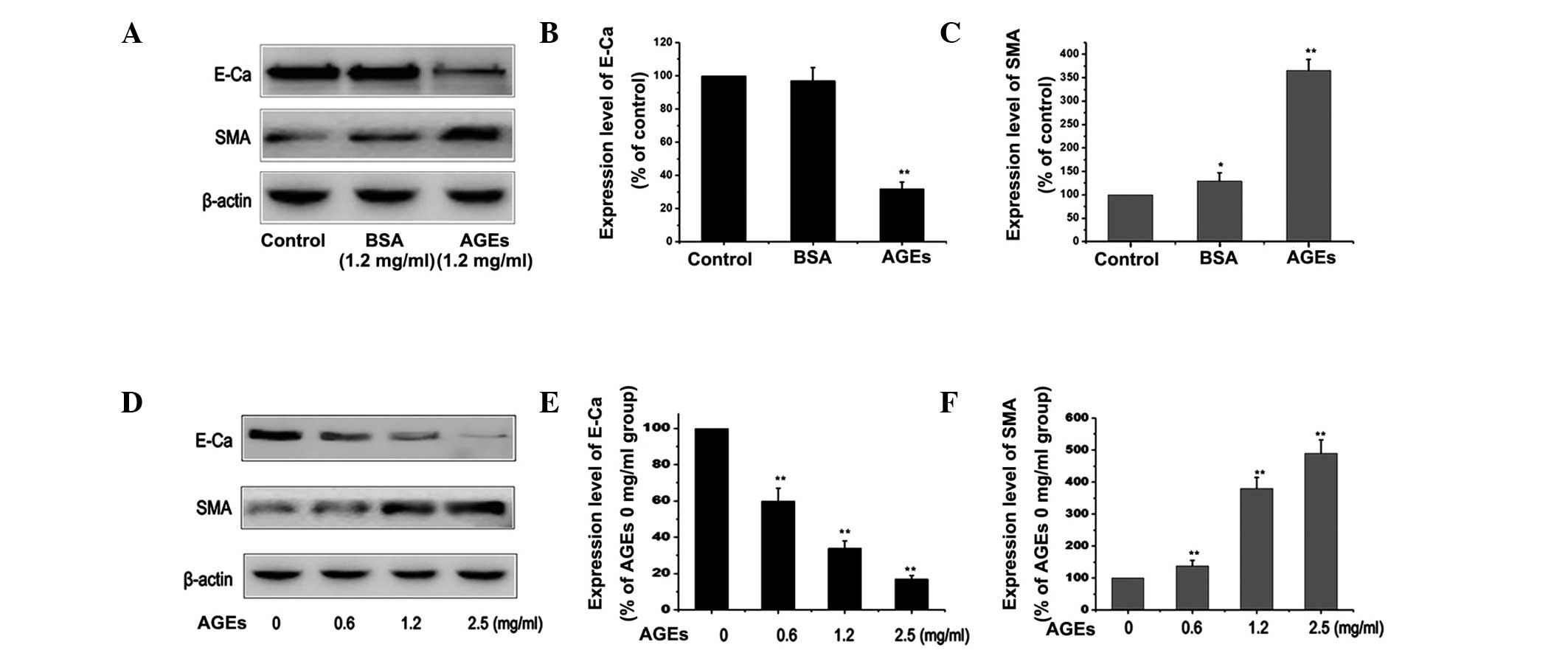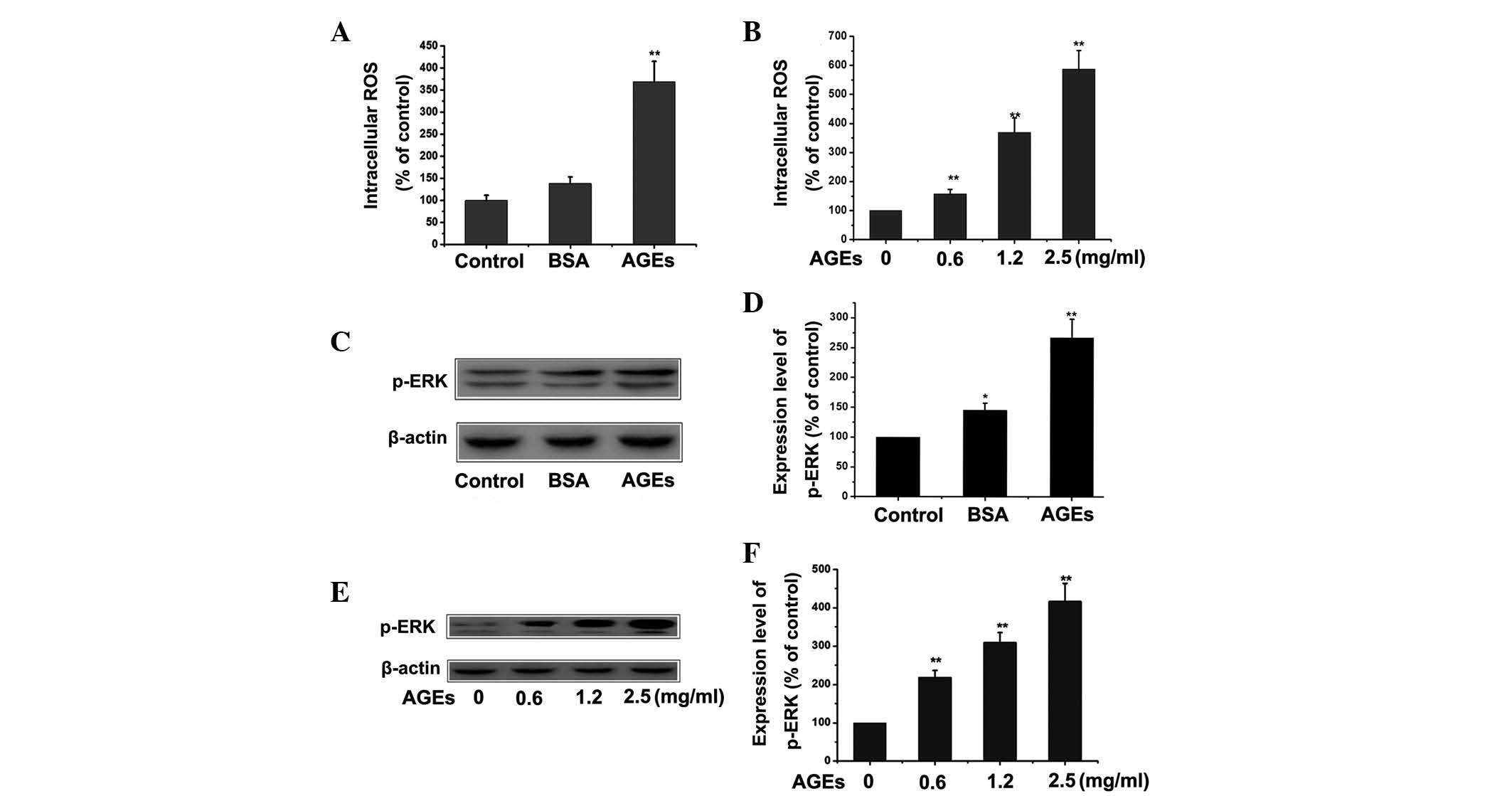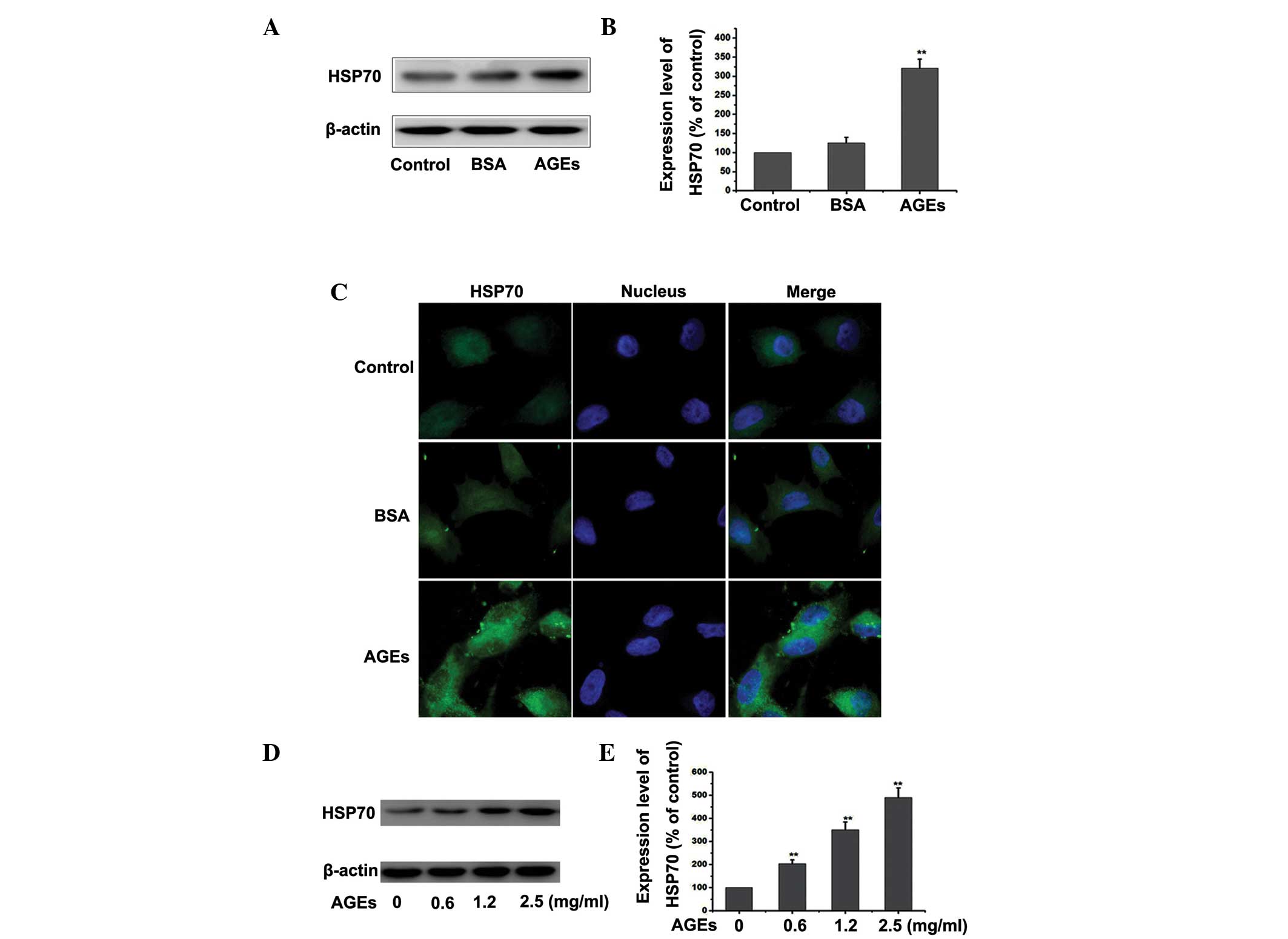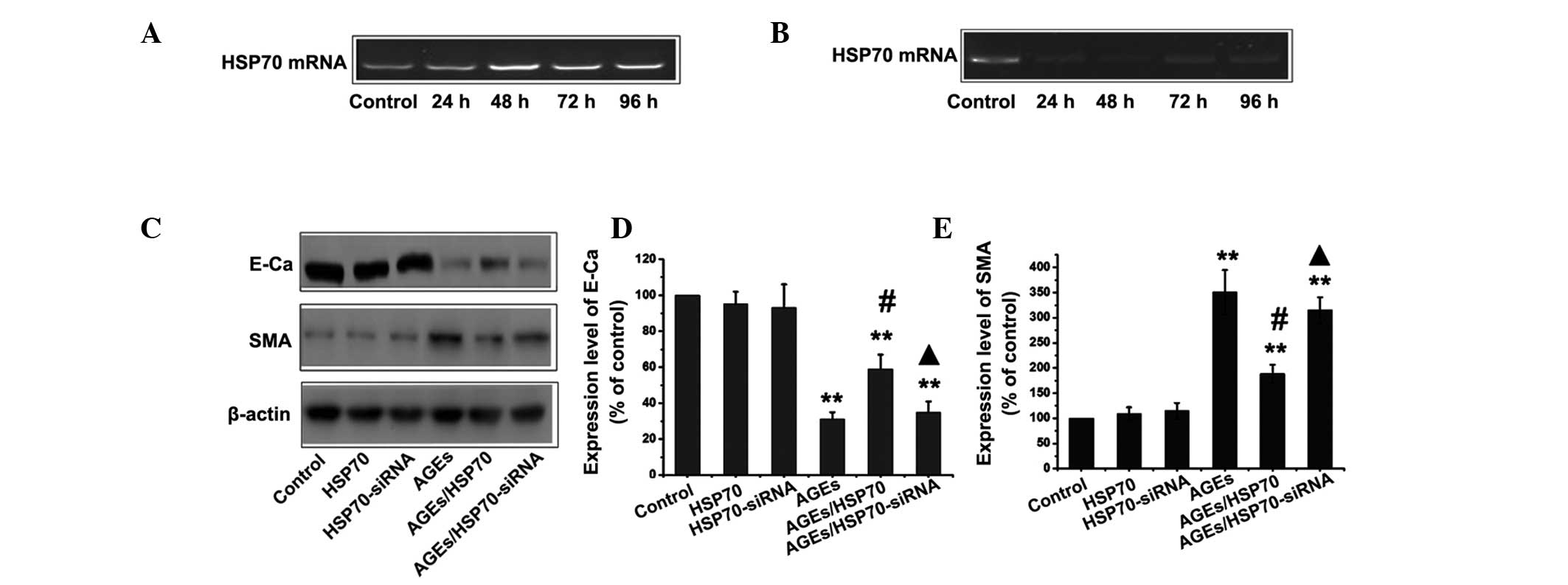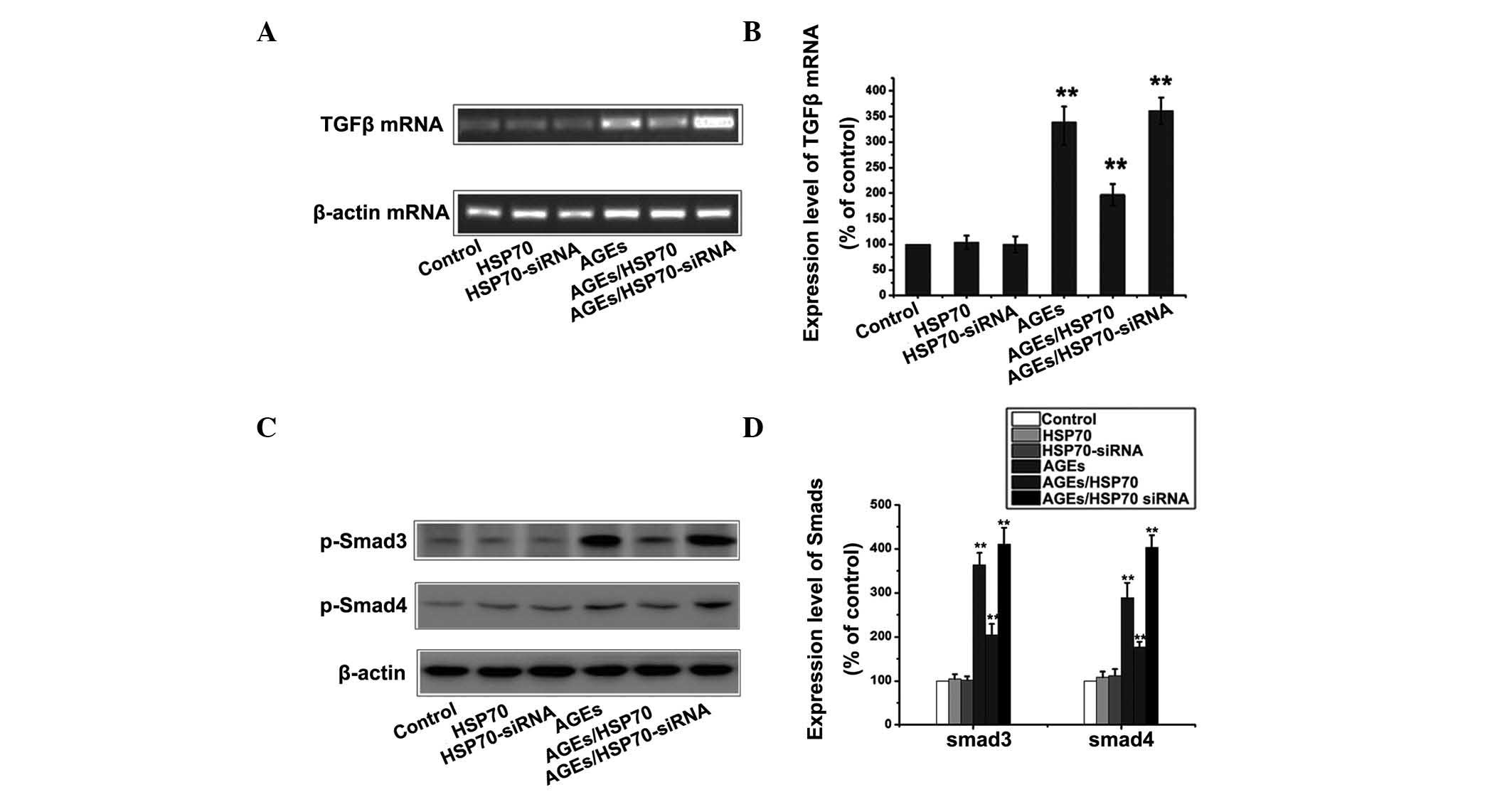Heat shock protein 70 protects rat peritoneal mesothelial cells from advanced glycation end-products-induced epithelial-to-mesenchymal transition through mitogen‑activated protein kinases/extracellular signal-regulated kinases and transforming growth factor-β/Smad pathways
- Authors:
- Published online on: January 29, 2015 https://doi.org/10.3892/mmr.2015.3271
- Pages: 4473-4481
Abstract
Introduction
Hemodialysis (HD) and peritoneal dialysis (PD) are the primary dialysis modalities used for patients with end-stage renal disease (ESRD). PD is a simple, ‘low-tech’ form of renal replacement therapy that is less expensive than conventional in-center hemodialysis in numerous parts of the world (1). Since 1980, there has been a rapid increase in the number of patients receiving PD (2). In 2008, the number of patients receiving PD globally was ~196,000, which accounted for 11% of the total number of those on dialysis. In total, 59% were treated in developing countries and 41% in developed countries (3). The number of patients worldwide who were treated with PD increased from 1997 to 2008, with a 2.5-fold increase in the prevalence of patients receiving PD in developing countries (3). However, due to continuous exposure to non-biocompatible PD solution, the peritoneal membrane undergoes structural and functional alterations, which ultimately lead to peritoneal fibrosis and therefore limit the long-term clinical application of PD (4,5).
The use of glucose-based peritoneal dialysis fluid (PDF) has a number of disadvantages, including high concentrations of hyperosmotic glucose and glucose degradation products (GDPs), which may activate various inflammatory cytokines and growth factors that result in damage to the peritoneum and the development of fibrosis in peritoneal mesothelial cells (PMCs). Recent studies have shown that high glucose peritoneal dialysis solutions may result in peritoneal fibrosis (6,7). However, further research is required into the induction of peritoneal fibrosis by glucose degradation products.
Heat sterilization of glucose-based PDFs produces GDPs, which accelerate the formation of advanced glycation end-products (AGEs) within the peritoneal cavity. The accumulation of AGEs is observed in peritoneal mesothelial and submesothelial layers in patients on continuous ambulatory PD (CAPD), in association with peritoneal thickening (8,9). However, the role of AGEs in the development of peritoneal fibrosis has remained elusive.
HSP70, a member of the heat-shock family of proteins, is an ATP-dependent molecular chaperone. It participates in numerous signaling pathways that are involved in growth control, cell survival and developmental processes (10). However, the role of HSP70 in AGEs-induced epithelial-to-mesenchymal transition (EMT) of peritoneal mesothelial cells remains to be elucidated. The present study aimed to investigate the mechanisms of AGEs-induced EMT, changes in the expression of HSPs, as well as the role of HSP70 in peritoneal mesothelial cells during EMT.
Materials and methods
Reagents
AGEs were obtained from (Sigma-Aldrich, St. Louis, MO, USA). Dulbecco’s modified Eagle’s medium (DMEM)/F12 and fetal bovine serum (FBS) were obtained from Gibco Laboratories (NY, New York, USA). Dimethyl sulfoxide (DMSO) and Triton X-100 were purchased from Sigma-Aldrich. Mouse monoclonal immunglobulin (Ig)G anti-β-actin (1:400) and rabbit polyclonal IgG anti-phospho (p)-Smad3,4 (1:400) antibodies were obtained from Santa Cruz Biotechnology, Inc. (Dallas, TX, USA). Mouse monoclonal IgG1 anti-α-smooth muscle actin (α-SMA; 1:400) and mouse monoclonal IgG1 anti-E-cadherin (1:400) antibodies were obtained from BD Biosciences (Heidelberg, Germany), mouse monoclonal IgG anti-HSP70 (1:400) was obtained from Sigma-Aldrich. An enhanced chemiluminescence (ECL) kit was obtained from Pierce Biotechnology, Inc. (Rockford, IL, USA). The reverse transcription-polymerase chain reaction (RT-PCR) kit was obtained from Toyobo Co., Ltd. (Osaka, Japan). The flow cytometer (FACSCalibur), was obtained from Becton-Dickinson (Franklin Lankes, NJ, USA). All reagents used were of trace element analysis grade. All water used was glass distilled.
Isolation of RPMCs and identification
A total of 4 Sprague-Dawley rats (aged, 12–16 weeks; weight, 0.2–0.4 kg) of both genders were used for the following experiments. All animal procedures were approved by the ethics committee of Xinxiang Medical University (Henan, China) and were performed in compliance with the European Economics Community regulations (O.J. of E.C.L358 12/18/1986) and the National Institute of Health standards (11). Rat peritoneal mesothelial cells (RPMCs) were isolated and cultured. Briefly, surgically resected omenta from sacrificed Sprague-Dawley rats were digested with 0.125% trypsin (Sigma-Aldrich) for 25 min at 37°C, followed by neutralization with DMEM/F12 medium supplemented with 10% FBS. The suspension was centrifuged at 60 × g for 5 min at 4°C and the pellet was resuspended in DMEM/F12 with 10% FBS. Following incubation for 1–3 days at 37°C, the medium was changed for the first time. Cells were then transferred to serum-free DMEM/F12 medium for overnight starvation prior to subsequent experiments. RPMCs were observed under a phase contrast inverted microscope (CKX41; Olympus Corp., Tokyo, Japan) and identified using immunocytochemistry. RPMCs were treated with various concentrations of AGEs (0, 0.6, 1.2 and 2.5 mg/ml) for 24 h.
Immunocytochemistry (ICC)
Cells were grown on 96-well imaging plates (BD Biosciences) and fixed using 4% w/v paraformaldehyde in 1X phosphate-buffered saline (PBS; NaCl, KCl, Na2HPO4, K2HPO4, CaCl2, MgCl2•6H2O, ddH2O) with Ca2+ and Mg2+ for 30 min at room temperature. Cells were washed with PBS and a blocking buffer [4% v/v normal donkey serum (NDS)/normal goat serum (NGS), 1% w/v bovine serum albumin (BSA; Sigma-Aldrich) and 0.1% Triton-X 100 in PBS, pH 7.4] was applied for 30 min at room temperature. The following primary antibodies were diluted in Ab solution (2% v/v NDS/NGS, 0.5% w/v BSA and 0.05% Triton-X 100 in PBS) and applied to cells for incubation overnight at 4°C: Cytokeratin (sc-57004; 1:400), vimentin (sc-373717; 1:400), VIII-related antigen (sc-366000; 1:200) and CD45 (sc-28369; 1:200) (Santa Cruz Biotechnology, Inc.). Following washing with PBS, the secondary antibodies (FITC-conjugated and tetramethylrhodamine-conjugated goat anti-mouse IgG antibodies; Santa Cruz Biotechnology, Inc.) were diluted in Ab solution and applied at room temperature for 1 h. Cells were subsequently washed and Hoescht stain (Sigma-Aldrich) was applied prior to the addition of antifade reagent (CitiFluor Ltd., London, UK), which was then left to permeate at room temperature for 1 h prior to imaging with the GPJ9-TS100-F fluorescence microscope (Nikon Corp., Tokyo, Japan). RPMCs were positive for cytokeratin and vimentin and negative for factor VIII-related antigen and leukocyte CD45 antigen.
Detection of intracellular reactive oxygen species (ROS) levels
In order to determine ROS generation within AGEs-treated cells, FACS analysis was performed. Cells were stained with 5 μg/ml DCF-DA for 30 min and subjected to flow cytometry using a Becton-Dickinson FACSCalibur prior to analysis by Cell Quest software, version 5.2.1 (Becton-Dickinson).
RNA interference plasmid construction and transient transfection
Small interfering RNA (siRNA) corresponding to the rat HSP70 cDNA was generated by cloning the synthesized oligonucleotide into pSilencer 2. 1-U6-neo plasmid by Genechem Co. (Shanghai, China). The following sequences for anti-Hsp70 were used: Forward, 5′-UUACCUGGCUCUUUGCUGCUGCUCC-3′ and reverse, 5′-GGAGCAGCAGCAAAGAGCCAGGUAA-3′. The siRNA-HSP70 targeting sequences matched exactly with partial sequences of the rat HSP70 gene, but not with any other known genes. The control siRNA did not match any known rat gene. According to the manufacturer’s instructions, transient transfections were performed using Lipofectamine 2000 (Invitrogen Life Technologies, Carlsbad, CA, USA). These experiments were performed in six-well culture plates. Transfection efficiency averaged between 50–60%. Cells were allowed to recover in medium for 24 h following transfection. The cultures were then treated with agents and subjected to further analysis.
HSP70 overexpression plasmid construction and transient transfection
According to the manufacturer’s instructions, plasmids expressing HSP70-cDNA gene were transfected into RPMCs using Lipofectamine 2000. These experiments were performed in six-well culture plates. Transfection efficiency averaged between 50–60%.
Preparation of total cellular proteins
RPMC lysates were prepared using 20 mM Tris-HCl, pH 7.4; 150 mM NaCl; 1% Triton X-100; 2.5 mM EDTA; 2.5 mM EGTA; and 1:200 protease inhibitor (Calbiochem, La Jolla, CA, USA). Lysates were kept on ice for 30 min and centrifuged at 10,000 × g for 10 min at 4°C. Protein concentration was determined using a bicinchoninic acid protein assay kit (Pierce Biotechnology, Inc.) according to the manufacturer’s instructions.
Western blot analysis
Samples containing 10 μg protein were electrophoresed and then transferred to nitrocellulose membranes (Millipore, Billerica, MA, USA). The nitrocellulose membrane was cut according the molecular weight of protein and incubated with primary antibodies. The following primary antibodies were used: Anti-α-SMA (1:400), anti-β-actin (1:400), anti-E-cadherin (1:400), anti-HSP70 (1:400) and anti-phospho Smad3,4 (1:400), and incubated overnight at 4°C. The horseradish peroxidase-conjugated secondary IgG antibodies (goat anti-mouse and goat anti-rabbit; 1:5000; Santa Cruz Biotechnology, Inc.) were subsequently appliedfor 1 h at 4°C. Detection was performed using the ECL kit. The quantity of each protein was measured relative to that of β-actin. The results were quantified by Quantity One Software v4.62 (Bio-Rad Laboratories, Hercules, CA, USA).
Fluorescence microscopy
RPMCs were seeded in six-well plates for 24 h. Cells were washed once with ice-cold PBS and fixed with 4% paraformaldehyde (Sigma-Aldrich) for 30 min at 4°C. Cells were then washed with PBS three times and incubated with 1% Triton X-100 for 10 min. Cells were blocked at nonspecific antibody binding sites by incubating with 10% goat serum (Gibco Laboratories) in PBS containing 0.3% Triton X-100 and 0.5% BSA for 30 min at room temperature, followed by incubation with a mouse monoclonal antibody against HSP70 (1:400) overnight. A fluorescein isothiocyanate-conjugated goat anti-mouse IgG antibody (1:100 in PBS) was added and incubated for 0.5 h at room temperature. Hoechst 33342 (Sigma-Aldrich) was added to the cells for 15 min. Cells were washed three times with PBS and visualized under fluorescence microscopy (GPJ9-TS100-F; Nikon Corp.).
RT-PCR
Total RNA from cultured cells was isolated using TRIzol reagent (Invitrogen Life Technologies). RNase-free DNase I was used in order to eliminate genomic DNA contamination in the RNA samples. The 260/280 absorbance ratio was measured for verification of the purity of RNA. The sequences of the HSP70 and β-actin genes were obtained from the GenBank database (www.ncbi.nlm.nih.gov/genbank/), and specific primers for them were designed over an exon-exon junction using Primer Premier 5.0 (Premier Biosoft, Palo Alto, CA). The following primers were used: Forward, 5′-AGCGGGAAATCGTCGGTG-3′, and reverse, 5′-GGGTACATGGTGGTGCCG-3′ for β-actin; forward, 5′-ACCAACTATTGCTTCAGCTC-3′ and reverse, 5′-CTTGCAGGAGCGCACGATCA-3′ for transforming growth factor-β (TGF-β); and forward, 5′-TACATATGGCCAAAGCCGCGGCAGTCG-3′ and reverse, 5′-TGCTCGAGATCTACCTCCTCAATGGTGGG-3′ for HSP70. PCR reactions were performed using a Gene Amp PCR system 9700 (PerkinElmer, Inc., Waltham, MA, USA) and amplified as follows: cDNA templates were initially heat-denatured at 94°C for 3 min followed by 94°C for 1 min, annealing at 58–65°C for 1 min, extension at 72°C for 1 min (35 cycles) and a final extension cycle at 72°C for 10 min. The amplified products were separated by electrophoresis on a 2% agarose gel (Sigma-Aldrich) and visualized by ethidium bromide staining (Sigma-Aldrich). Image density was quantified using a FluoroImager SI (GE Healthcare, Little Chalfont, UK).
Statistical analysis
Values are expressed as the mean ± standard error of the mean. Statistical significance was established by analysis of variance and individual comparisons were then made using Tukey’s multiple comparison test. P<0.05 was considered to indicate a statistically significant difference. Statistical analysis was performed using SPSS Version 18 (International Business Machines, Armonk, NY, USA).
Results
Effect of AGEs on EMT in PMCs
In order to elucidate the mechanism underlying the induction of EMT by AGEs, the expression of E-cadherin and α-SMA in RPMCs was measured under different conditions. The PMCs were cultured with 1.2 mg/ml BSA or 1.2 mg/ml AGEs for 24 h. The results demonstrated that treatment with AGEs decreased the expression of the E-cadherin protein and increased that of the α-SMA protein, compared with those in the control or BSA group (P<0.01; Fig. 1A–C). Western blotting showed a dose-dependent change in the expression of EMT-associated proteins in AGE-treated PMCs (Fig. 1D–F). The results indicated that AGEs induced EMT and led to increased EMT events in PMCs.
AGEs activate the TGF-β/Smad pathway in RPMCs
The TGF-β/Smad signaling pathways have been reported to be involved in EMT (12). The present study aimed to investigate whether TGF-β/Smad signaling in RPMCs is involved in AGEs-induced EMT. RPMCs were treated with 1.2 mg/ml BSA or 1.2 mg/ml AGEs for 24 h in order to induce EMT, and the expression of TGF-β mRNA and p-Smad3,4 were detected by RT-PCR and western blotting, respectively. Under controlled conditions (1.2 mg/ml BSA for 24 h), administration of BSA did not increase the levels of TGF-β mRNA and the p-Smad protein. By contrast, following exposure to AGEs, levels of TGF-β mRNA and p-Smad3,4 protein were found to be markedly increased compared with those in the control or BSA group (Fig. 2A and E). Fig. 2C and H show a dose-dependent change in the expression of TGF-β mRNA and p-Smad3,4 in PMCS treated with AGEs, as detected by RT-PCR and western blotting. These results supported the hypothesis that AGEs effectively activate the TGF-β/Smad signaling pathways.
AGEs activate the ROS/mitogen-activated protein kinases (MAPK)-extracellular signal-regulated kinases (ERK) pathway in RPMCs
The ROS/MAPK-ERK signaling pathway has been reported to be involved in EMT (13,14). The present study aimed to investigate whether ROS/MAPK-ERK signaling in RPMCs is involved in AGEs-induced EMT. RPMCs were treated with 1.2 mg/ml BSA or 1.2 mg/ml AGEs for 24 h in order to induce EMT. Cells were then stained with DCF-DA in order to detect intracellular ROS production. The expression of p-ERK was detected by western blotting. Following culture with AGEs, intracellular levels of ROS and p-ERK were found to be markedly increased compared with those in the control or BSA group (Fig. 3A and C). Fig. 3E shows a dose-dependent change in the expression of p-ERK in PMCs treated with AGEs, as detected by western blotting. These results supported the hypothesis that AGEs effectively activated the ROS/MAPK-ERK signaling pathway.
AGEs upregulate the expression of HSP70 in RPMCs
HSP70 may be upregulated by numerous stresses within cells, including heat, oxidative stress and chemical injury (15). Therefore, the present study explored whether treatment of PMCs with AGEs altered the expression of HSP70. Cells were treated with 1.2 mg/ml BSA or 1.2 mg/ml AGEs for 24 h and the expression of HSP70 was detected by western blotting and fluorescence microscopy. As shown in Fig. 4A–C, treatment with AGEs increased the levels of HSP70. This induction was sustained following AGEs stimulation, in comparison with the control or the BSA group. As shown in Fig. 4D and E, there was a dose-dependent increase in the expression of HSP70 in PMCs treated with AGEs, as detected by western blotting. The results demonstrated that AGEs upregulated the expression of HSP70 in RPMCs.
HSP70 inhibits AGEs-induced EMT in RPMCs
In order to investigate whether HSP70 protects against AGEs-induced EMT, PMCs were transfected with a plasmid expressing the HSP70-cDNA gene or siRNA-HSP70. RT-PCR analysis was performed on isolated total RNA in order to measure the level of HSP70 mRNA following HSP70-pcDNA3.1/myc-HisA and HSP70-siRNA transfection for various time periods (Fig. 5A and B). When cells were transfected with HSP70-pcDNA3.1/myc-HisA, the expression of HSP70 was significantly increased compared with that in the control groups and HSP70 levels peaked at 48 h. By contrast, HSP70 expression was decreased compared with that in the control group following transfection with siRNA-HSP70. The lowest expression of HSP70 was found 48 h following transfection with siRNA-HSP70. The control group, HSP70-overexpressing group and HSP70-siRNA groups were then treated with or without 1.2 mg/ml AGEs for 24 h, following which the levels of the E-cadherin and α-SMA proteins were assessed by western blotting. As shown in Fig. 5C, overexpression of HSP70 significantly decreased AGEs-induced EMT, as evidenced by the reduction in the upregulation of α-SMA and the ameliorated expression of the epithelial protein E-cadherin. By contrast, siRNA-mediated suppression of HSP70 exacerbated AGE-induced EMT. Of note, treatment with siRNA plasmids expressing HSP70 alone did not induce EMT-mediated events in RPMCs.
HSP70 inhibits the TGF-β/Smad pathway in RPMCs treated with AGEs
In order to investigate whether HSP70 activates or inhibits TGF-β/Smad signaling in RPMCs during AGEs-induced EMT, the control group, HSP70-overexpression group and HSP70-siRNA group were treated with or without 1.2 mg/ml AGEs for 24 h, following which the expression of TGF-β mRNA and p-Smad3,4 were detected by RT-PCR and western blotting. As shown in Fig. 6, overexpression of HSP70 significantly inhibited the TGF-β/Smad signaling pathway, as indicated by the reduction in the AGEs-induced upregulation of TGF-β and p-Smad3,4. By contrast, siRNA-mediated suppression of HSP70 exacerbated the AGEs-induced activation of the TGF-β/Smad signaling pathway.
HSP70 inhibits the ROS/MAPK-ERK pathway in AGEs-treated RPMCs
In order to investigate whether HSP70 activates or inhibits ROS/MAPK-ERK signaling in RPMCs during AGEs-induced EMT, the control group, HSP70-overexpression group and HSP70-siRNA group were treated with or without 1.2 mg/ml AGEs for 24 h, following which the expression of p-ERK and intracellular ROS production were measured. As shown in Fig. 7, overexpression of HSP70 significantly inhibited the ROS/MAPK-ERK signaling pathway, as demonstrated by the reduction in the AGEs-induced upregulation of intracellular ROS production and p-ERK expression. By contrast, siRNA-mediated suppression of HSP70 further exacerbated AGEs-induced activation of the MAPK-ERK signaling pathway.
Discussion
AGEs result from a series of non-enzymatical reactions, forming Schiff base and Amadori compounds that are generated from glucose and other reducing sugars. AGEs accumulate in diverse pathological conditions, including atherosclerosis and oxidative modifications that alter cellular structure, function and inflammation (16,17). When peritoneal proteins are exposed to high-glucose dialysate during long-term PD, a glycosylation reaction occurs, producing AGEs. Diabetic kidney disease is a primary cause of morbidity and mortality in diabetic patients. Longitudinal hyperglycemia increases intracellular sugars and the derivatives of these may be involved in glycation and AGE formation (18). AGEs are normally excreted in urine in healthy subjects with a high renal clearance. However, this clearance markedly declines in patients with chronic renal failure. Accumulation of AGEs is further increased in patients with end stage renal disease on PD or HD as a result of increased AGE formation (19). Therefore, the present study aimed to investigate whether AGEs are involved in the formation of peritoneal fibrosis.
EMT is important in the processes of cellular transdifferentiation during embryonic development, tumour invasion and metastasis as well as in the development of tissue fibrosis (20). EMT is involved in fibroblast genesis during organ fibrosis in adult tissues. A previous study demonstrated that PMCs underwent EMT during PD (21). The present study investigated whether the effects of AGEs in the development of peritoneal fibrosis are due to EMT. As shown in Fig. 1, treatment with AGEs reduced the expression of the E-cadherin protein, increased the expression and led to increased EMT events in PMCs. A previous study showed that TGF-β/Smads signaling is important in the promotion of EMT (22). The present study demonstrated that a dose-dependent change in the expression of TGF-β mRNA and p-Smad3,4 was induced by AGE treatment of PMCs. These results support the hypothesis that AGEs effectively activate the TGF-β/Smad signaling pathways. Although the molecular regulation underlying the EMT has been extensively studied in other cell systems, predominantly in tumor cells, the signaling pathways involved in this process have remained to be fully elucidated. The present study demonstrated that the ROS/MAPK-ERK signaling pathway participated in the AGE-induced EMT in RPMCs.
The HSP70 protein family and their co-chaperones constitute a complex network of folding machines which is utilized by cells in numerous ways, allowing them to adapt to gradual changes in their environment and to survive in what would otherwise be lethal conditions (23). With respect to the HSP70 proteins it is elusive whether their activity inhibits EMT in RPMCs. The present study demonstrated that stimulation by AGEs upregulated the expression of HSP70, which in turn reduced EMT. The effects of HSP70 were investigated by modulating HSP70 expression through siRNA knockdown and plasmid overexpression. Overexpression of HSP70 significantly reduced AGEs-induced EMT, while siRNA-mediated suppression of HSP70 exacerbated AGE-induced EMT. Furthermore, HSP70 inhibited the TGF-β/Smad and ROS/MAPK-ERK signaling pathways, thereby antagonizing EMT-associated events.
In conclusion, the present study provided a detailed assessment of the capacity of HSP70 to weaken or inhibit AGE-induced EMT in PMCs. AGE-induced EMT occurs via independent mechanisms, involving the TGF-β/Smad signaling pathway and ROS/MAPK-ERK activation. Furthermore, HSP70 was shown to inhibit these two pathways. The potential role of HSP70 in EMT, as well as the involvement of upstream and downstream signaling molecules, requires further investigation in order to identify possible therapeutic targets, which may inhibit EMT in peritoneal fibrosis.
Abbreviations:
|
HD |
hemodialysis |
|
PD |
peritoneal dialysis |
|
ESRD |
end-stage renal disease |
|
RPMCs |
rat peritoneal mesothelial cells |
|
AGE |
advanced glycation end-products |
|
DMEM |
Dulbecco’s modified Eagle’s medium |
|
FITC |
fluorescein isothiocyanate |
|
RIPA |
radioimmunoprecipitation assay |
|
TGF |
transforming growth factor |
|
EMT |
epithelial-to-mesenchymal transition |
|
SMA |
smooth muscle cell actin |
|
ROS |
reactive oxygen species |
|
MAPKs |
mitogen-activated protein kinases |
|
ERK |
extracellular signal-regulated protein kinases |
References
|
Bargman JM: Advances in peritoneal dialysis: a review. Semin Dial. 25:545–549. 2012. View Article : Google Scholar : PubMed/NCBI | |
|
Chou CY, Liang CC, Kuo HL, et al: Comparing risk of new onset diabetes mellitus in chronic kidney disease patients receiving peritoneal dialysis and hemodialysis using propensity score matching. PLoS One. 9:e878912014. View Article : Google Scholar : PubMed/NCBI | |
|
Jain AK, Blake P, Cordy P and Garg AX: Global trends in rates of peritoneal dialysis. J Am Soc Nephrol. 23:533–544. 2012. View Article : Google Scholar : PubMed/NCBI | |
|
Williams JD, Craig KJ, Topley N, Von Ruhland C, Fallon M, Newman GR, Mackenzie RK and Williams GT; Peritoneal Biopsy Study Group: Morphologic changes in the peritoneal membrane of patients with renal disease. J Am Soc Nephrol. 13:470–479. 2002.PubMed/NCBI | |
|
Li XJ, Sun L, Xiao L and Liu FY: Gene delivery in peritoneal dialysis related peritoneal fibrosis research. Chin Med J (Engl). 125:2219–2224. 2012. | |
|
Zhang J, Bi M, Zhong F, Jiao X, Zhang D and Dong Q: Role of CIP4 in high glucose induced epithelial-mesenchymal transition of rat peritoneal mesothelial cells. Ren Fail. 35:989–995. 2013. View Article : Google Scholar : PubMed/NCBI | |
|
Baroni G, Schuinski AF, Berticelli PT, Silva MA, Gouveia DS, Pecoits Filho R and Meyer F: The influence of simvastatin in induced peritoneal fibrosis in rats by peritoneal dialysis solution with glucosis 4.25%. Acta Cir Bras. 27:350–356. 2012. View Article : Google Scholar : PubMed/NCBI | |
|
Nakamura S and Niwa T: Advanced glycation end-products and peritoneal sclerosis. Semin Nephrol. 24:502–505. 2004. View Article : Google Scholar : PubMed/NCBI | |
|
Witowski J, Bender TO, Gahl GM, Frei U and Jörres A: Glucose degradation products and peritoneal membrane function. Perit Dial Int. 21:201–205. 2001.PubMed/NCBI | |
|
Mayer MP and Bukau B: Hsp70 chaperones: cellular functions and molecular mechanism. Cell Mol Life Sci. 62:670–84. 2005. View Article : Google Scholar : PubMed/NCBI | |
|
National Research Council (US) Institute for Laboratory Animal Research: Guide for the care and Use of Laboratory Animals. National Academies Press; Washington (DC), WA, USA: pp. 86–23. 1996 | |
|
Neil JR, Johnson KM, Nemenoff RA and Schiemann WP: Cox-2 inactivates Smad signaling and enhances EMT stimulated by TGF-beta through a PGE2-dependent mechanisms. Carcinogenesis. 29:2227–2235. 2008. View Article : Google Scholar : PubMed/NCBI | |
|
Elsum IA, Martin C and Humbert PO: Scribble regulates an EMT polarity pathway through modulation of MAPK-ERK signaling to mediate junction formation. J Cell Sci. 126:3990–3999. 2013. View Article : Google Scholar : PubMed/NCBI | |
|
Xie L, Law BK, Chytil AM, Brown KA, Aakre ME and Moses HL: Activation of the Erk pathway is required for TGF-beta1-induced EMT in vitro. Neoplasia. 6:603–610. 2004. View Article : Google Scholar : PubMed/NCBI | |
|
Mikuriya T, Sugahara K, Takemoto T, Tanaka K, Takeno K, Shimogori H, Nakai A and Yamashita H: Geranylgeranylacetone, a heat shock protein inducer, prevents acoustic injury in the guinea pig. Brain Res. 1065:107–114. 2005. View Article : Google Scholar : PubMed/NCBI | |
|
Aso Y, Inukai T, Tayama K and Takemura Y: Serum concentrations of advanced glycation endproducts are associated with the development of atherosclerosis as well as diabetic microangiopathy in patients with type 2 diabetes. Acta Diabetol. 37:87–92. 2000. View Article : Google Scholar | |
|
Wang X, Desai K, Juurlink BH, de Champlain J and Wu L: Gender-related differences in advanced glycation endproducts, oxidative stress markers and nitric oxide synthases in rats. Kidney Int. 69:281–287. 2006. View Article : Google Scholar : PubMed/NCBI | |
|
Yamabe N, Kang KS, Park CH, Tanaka T and Yokozawa T: 7-O-galloyl-D-sedoheptulose is a novel therapeutic agent against oxidative stress and advanced glycation endproducts in the diabetic kidney. Biol Pharm Bull. 32:657–664. 2009. View Article : Google Scholar : PubMed/NCBI | |
|
Thornalley PJ: Glycation free adduct accumulation in renal disease: the new AGE. Pediatr Nephrol. 20:1515–1522. 2005. View Article : Google Scholar : PubMed/NCBI | |
|
Roche J, Nasarre P, Gemmill R, Baldys A, Pontis J, Korch C, Guilhot J, Ait-Si-Ali S and Drabkin H: Global decrease of histone H3k27 acetylation in ZEB1-induced epithelial to mesenchymal transition in lung cancer cells. Cancers (Basel). 5:334–356. 2013. View Article : Google Scholar | |
|
Fang CC, Huang JW, Shyu RS, Yen CJ, Shiao CH, Chiang CK, Hu RH and Tsai TJ: Fibrin-induced epithelial-to-mesenchymal transition of peritoneal mesothelial cells as a mechanism of peritoneal fibrosis: effects of pentoxifylline. PLoS One. 7:e447652012. View Article : Google Scholar : PubMed/NCBI | |
|
Smith AL, Iwanaga R, Drasin DJ, Micalizzi DS, Vartuli RL, Tan AC and Ford HL: The miR-106b-25 cluster targets Smad7, activates TGF-β signaling and induces EMT and tumor initiating cell characteristics downstream of Six1 in human breast cancer. Oncogene. 31:5162–5171. 2012. View Article : Google Scholar : PubMed/NCBI | |
|
Selim ME, Rashed el HA, Aleisa NA and Daghestani MH: The protection role of heat shock protein 70 (HSP-70) in the testes of cadmium-exposed rats. Bioinformation. 8:58–64. 2012. View Article : Google Scholar : PubMed/NCBI |



